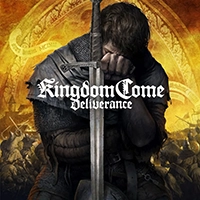

Rune Factory: Guardians of Azuma is the sixth entry in the Rune Factory series, a game that mixes farming and RPG elements. After the middling response for Rune Factory 5, Guardians of Azuma had a lot of work to do to fight against skeptical audiences. With that in mind, there are a slew of new features to bring about a new age in the Rune Factory series. But will these new features be enough to prop up the game, or will it fall into the same performance pitfalls as its predecessor?
Guardians of Azuma opens up with an intense fighting scene between two potential protagonists (one of which you selected before the cutscene begins) riding on dragons. However, before you can see what resulted from the battle, the screen fades to white and transitions to a village. It’s been six months since you arrived in a place known as the Spring Village, and since then, you’ve been helping out. But your assistance hasn’t done much to help the dying village. But things take a sharp turn when a black dragon suddenly appears, spreading Blightbloom spores to absorb the land’s runes. You chase off the dragon, and with this, you are kickstarted to help revitalize Spring Village, and soon after, all of Azuma.
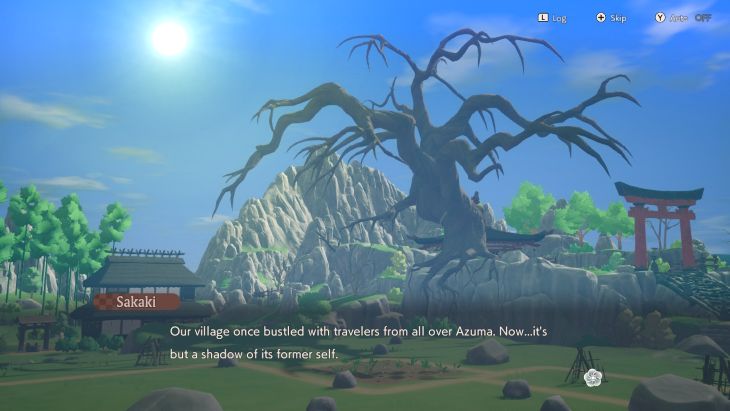
The story is your standard Rune Factory fare: save a village from an unknown threat. But with Guardians of Azuma, the story feels much larger than past games. Rather than dealing with one village and a small cast of characters to get familiar with, there are four different villages based on the different seasons. Along with those villages, there are islands in the sky that you can navigate to to complete side quests and gather items from. The general story beats are pretty good, but the story shines in its bond quests. Many of the characters do fall into the same pitfalls of being little more than tropes at first glance, but with the bond quest stories, more background is given to these characters that you’d otherwise not see in the main story.
As with other Rune Factory games, there is a bond system where you can get close to specific characters, either to develop deeper friendships or to be romantically involved. There are eight male and eight female characters to choose from (some of whom are locked behind DLC), and they are all available regardless of gender. Outside of the characters you can pursue romantically, there are bonding opportunities for all unique characters. All characters have levels to their bond, and with each level that is completed, you’ll unlock more activities that you can do with them, as well as potentially unlock the next part of their bond story.
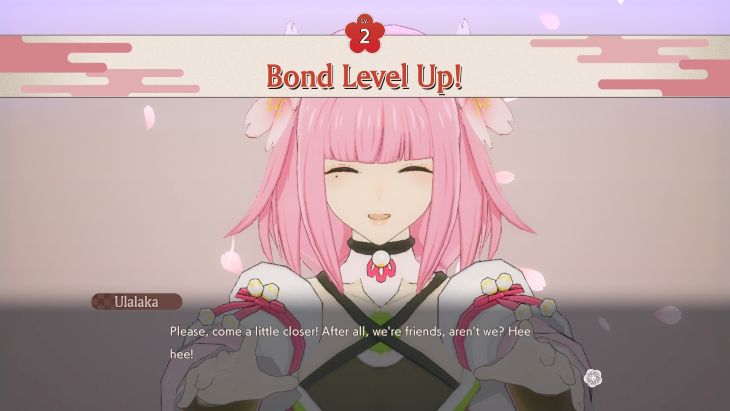
There are plenty of ways to increase your bond level with characters. Once per day, you can choose to hang out with a character and from there, select one of four random options. Most of these options will be going to a specific location with a character, such as the tea shop to eat, or to the beach to run around. Each character has their own likes and dislikes. If you take a character to a place that they love, you’ll gain more bond points. But if they don’t like where you’ve brought them, you don’t gain anything. Along with that, certain activities and locations require a certain bond level. While doing an activity one level higher is fine, if you try to perform an action higher than that, the character will outright reject your offer, and you’ll lose your chance to hang out for that day.
Rune Factory: Guardians of Azuma is an RPG farming game where you need to balance between going out to explore and fight, and maintaining your village. In this installment, however, there is more emphasis placed on exploring and fighting than there was in past games. In fact, after a certain point in the game, the farming ends up so much in the background that you tend to forget about it, since you are delegating tasks within the village to the villagers. You’ll spend a big chunk of your time exploring outside of the village, gathering items, fighting monsters, finding treasure, and progressing the story before coming back to the village and placing more buildings and decorations.
Outside of each village that you come to, there is an outer area that can be explored. This is where the monsters of the game reside, as well as many chests and treasures to find. These areas are fairly one-note, all of them being either corridors that lead right to the boss area or open plains for you to run around. In every area, there are frog statues and shrines, which can give you recipes upon finding them, chests that contain items to use for cooking or crafting, and even some hidden interactive items. The map does show most items that can be found, and once you’ve found them, they will disappear from the map.
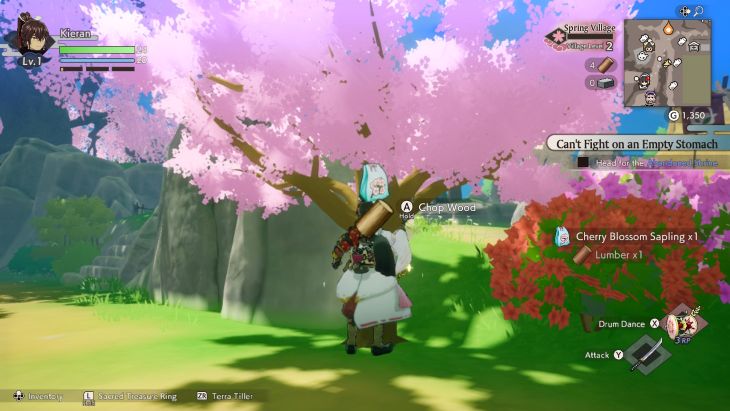
Along with treasures and shrines, there are plenty of ‘save’ statues sprawled about. These statues act as fast travel points, allowing you to go to any location where you’ve awakened a statue. There are also plenty of places to gather items. Trees and ore deposits are all over the map, and you’ll quickly find that you’ll have more lumber and ore than you’ll need to construct weapons and buildings. Trees and ore deposits refill after a day, so you can always come back the next day if you find yourself low on supplies.
Days operate the same in Rune Factory, with a full day passing relatively quickly in the game. There isn’t a hard limit that the game enforces for sleeping, like in past games, although at specific times, you will find your health dropping due to fatigue. If you do end the day by sleeping, your health and rune bars are refilled for the next day. The rune bar is only tied to your sacred treasures, so any action outside of using those items is not limited. If you find yourself low on RP, you can let time pass and have your RP bar refill naturally, or you can eat some food that refills the gauge.
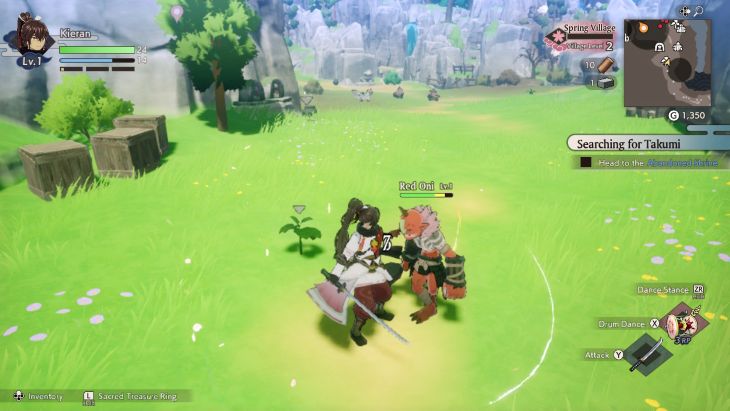
Combat is action-based, with a variety of weapons that can be used once you either find a weapon or unlock a recipe. Each weapon has its pros and cons, mainly dealing with how much damage a weapon deals and how fast or slow the weapon causes your attacks to land. Along with your main weapon, you can also equip a secondary weapon, such as a bow. You can use both weapons on the fly without actually switching weapons, which is helpful when dealing with flying enemies that are out of range of your melee weapons.
You can dodge, and if you can time your dodge just right, there is a perfect dodge that slows down time and allows you to attack at your normal speed, dealing massive damage. But if you’re looking to make use of that, be careful about spamming attacks. The game does lock you into a combo once you’ve pressed the buttons a certain number of times.
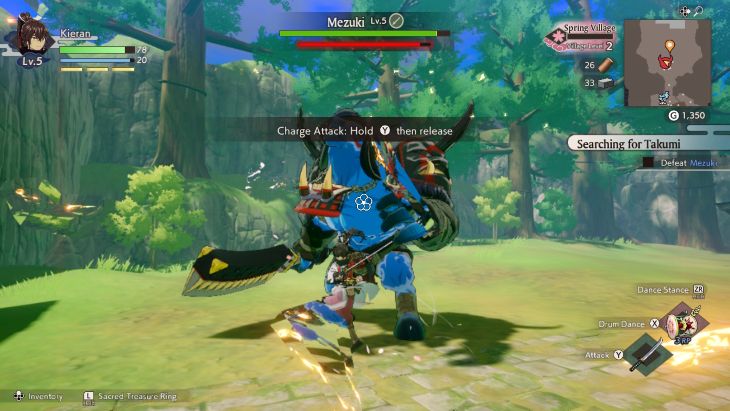
After specific points in the game, you’ll fight against a boss. Each boss has their own weak elements and weak points, although exploiting these is required to win the battle. One thing to keep in mind with bosses, however, is that they all will have a stun gauge that you’ll need to fill up before you can deal significant damage. The gauge fills up by dealing attacks, and once an enemy is stunned, they’ll no longer attack you and take greater damage. These moments are usually the best time to use your sacred treasure abilities, as they deal a lot of damage.
A major story point with Guardians of Azuma is building back up the villages after the blight robbed the land of runes. There are specific areas within the villages where you can place buildings and decorations. To create buildings and decorations, you’ll need to make use of a carpenter. Each building and decoration can have bonuses depending on the village, and while you can place items specific to one village in another, you won’t get any bonuses.
When it comes to this portion of the gameplay, it does feel a bit underbaked and clunky. The process of actually putting the buildings and decorations down feels awkward because you’re controlling your character while maneuvering the building, rather than controlling the building itself.
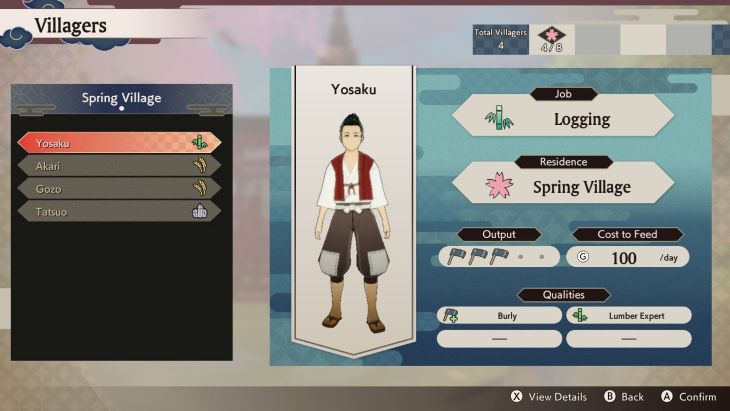
A new function of Guardians of Azuma is the Sacred Treasures. Sacred Treasures are obtained as you progress through the story, and they have functions in and outside of battle. During battle, the different treasures can act as special attacks, as you can only use the abilities when your special gauge has enough bars filled. Outside of battle, though, each treasure has its own ability. For example, the Sacred Drum can revive dead trees and increase the speed of your crops’ growth. Every treasure has its own use, and you’ll make use of every single one as you progress.
Each village has a level bar that shows you how much growth it has obtained. The higher your village level, the more people will come out to live in your village, and the more bustling the area will be. This also means more people will be around to help you gather items and farm in your village. But on the flipside, having more workers means paying more people. And yes, you do have to pay the villagers to help you, although the amount is minuscule compared to what you should be bringing in with just your crops alone.
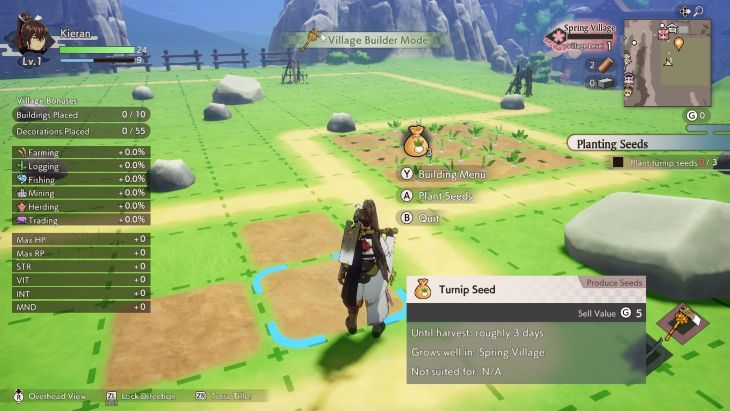
What was once a major part of the Rune Factory series has taken a bit of a step back with this new installment. You are still introduced to the aspect of farming and expected to create and maintain a farm. However, after a certain point, you are able to delegate much of the farming portions of the game to random villagers who live in your village. While the series had never really been known for its intricate farming gameplay, it is still bittersweet to see a step back from this part of its roots. Of course, you don’t have to make use of the villagers and can handle all of the farming yourself. But given the large scale of the game and how many different villages you’re helping, it just doesn’t feel feasible to handle everything.
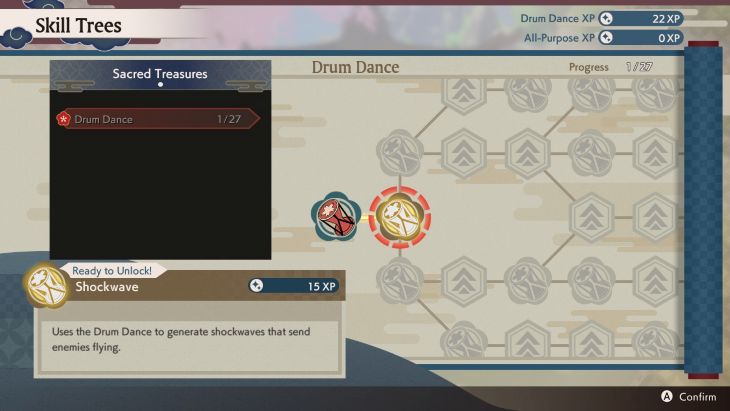
Along with your weapons, you are able to upgrade your treasures and your skills. Every type of item (weapons, treasures, general skills, etc.) has its own specialized experience that you gain as you perform specific actions. Along with specialized experience, there are also general experience points that are gained at the end of each day. How much experience you gain depends on the actions that you perform during the day, and the game outlines where every point comes from. But just as you can gain experience, you can also lose experience, mainly if you end up dying in battle or fainting due to staying up too late. In the skill trees, along with boosting your own stats, sometimes you can unlock new attacks associated with specific weapons.
Rune Factory: Guardians of Azuma has fully settled into its 3D design, and for the most part, the game looks fine on the original Nintendo Switch. During cutscenes, the game looks great, the models sleek, and the colors bright and vibrant. But when you’re playing through the game, there is a bit of a downgrade in how the game looks. Along with that, there are some performance issues when there is a large number of enemies on the screen, and even sometimes during the more intensive cutscenes. While not enough to be unplayable, it is noticeable while you’re playing.
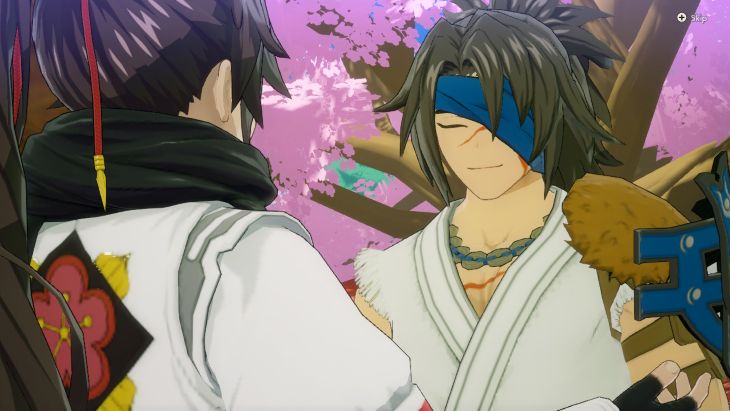
A strong point for the Rune Factory series has always been the character designs, and this installment is no different. All of the characters look great design-wise, with several of the cast dressed according to their village. The environments are less impressive, with the backgrounds feeling more like an afterthought. Along the same line, the bond animations are reused across all characters, which can make the general moments feel a bit cheap. It is understandable, though, given that there are more than 20 characters that you can perform bond activities with.
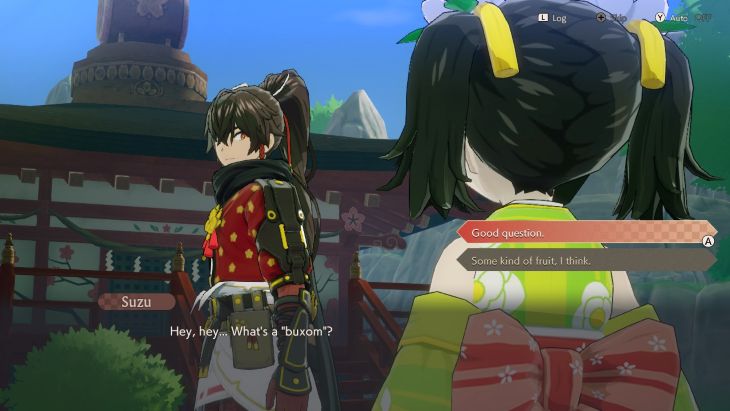
As with other titles, Guardians of Azuma is partially voice-acted, with instances outside of major cutscenes relegated to general grunts and shouts. There are Japanese and English voices available to choose from, and both sound fine. There isn’t quite a standout performance, but none of the voice acting dragged down the game either. The music is along the same lines, leaning heavily into a traditional Japanese angle. Many of the familiar Rune Factory songs have been revamped for this new title, along with some original tracks as well.
Rune Factory: Guardians of Azuma is a solid title that does feel a bit awkward in its execution. With less emphasis on farming and more placed on the story and village growth, it’s obvious that the team behind the Rune Factory series is feeling out how to continue with the series while bringing a fresh aspect to the game. The new additions, such as the Sacred Treasures and the village building, were a fun idea and brought a new dimension to battles and general gameplay. For farming fans, Guardians of Azuma feels as though it’s taking a step away from that portion of the game. But for fans of the story and combat of Rune Factory, you’ll find an enjoyable experience that is fun to play through.
Rune Factory: Guardians of Azuma gets a 7/10.